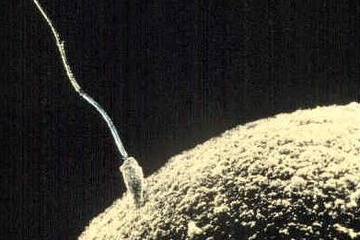Last week, I went to the California Cryobank wondering whether I genuinely wanted to contribute to this nation's gene pool or if I merely wanted a sensationalist behind-the-scenes scoop at the local sperm bank. Not surprisingly, the bank was not listed in the building's directory, so I went up to the 7th floor to the "health advisory institute," and hoped for the best. Opening the door, I asked the lady as quietly as possible if this was where one could make donations, praying, of course, she wouldn't answer loudly: "Donations? What kind of donations are you talking about exactly, son?" Instead, the receptionist nonchalantly rang up the bank and directed me to the first floor.
California Cryobank: it sounds like the Fort Knox of Fertilization storing millions upon millions of men's specimens in a huge vault. I expected a packed waiting room and hundreds of men whipping through the semen extraction process. But as God had willed it, the Cryobank was much less than I expected, handling, so to speak, a mere 15 men a day, Monday to Friday, 9 a.m. to 5 p.m. The waiting room was like that of any family practioner--nondescript furniture, carpeting and framed prints. Not a single Sports Illustrated to be found, I settled for Single Mom by Choice magazine. I soon learned that artificial insemination remains the luxurious alternative to adoption because it allows the mother-consumer to customize exactly how her final product will look and behave.
The receptionist was an extremely nice woman who seemed completely at ease working with human sperm on a daily basis. But as we went through some procedural stuff, I caught a glimpse of a tray of fresh samples oscillating wildly and shaking up their contents in the lab behind her. I chuckled nervously. The Beastie Boys played in the background as one of the lab assistants inspected a specimen under a microscope.
But let's be clear about this one thing: Not just any specimen that lands on that oscillating tray makes the grade. The Monty Python song notwithstanding, every sperm is not, in fact, sacred; each specimen is checked for sperm count, diseases and the like. Furthermore, as with any commodity in a free market, some sperm are more equal than others. To that elitist end, each donor must fill out a tedious, two-page questionnaire with questions like: Hair color? Straight hair, curly or wavy? Eye color? Left-handed or right-handed? Jewish ancestry? College? Major? High school? Family illnesses or health issues related to incest? Then I filled out a Mendelian race tree, delineating the race of my grandparents on down. The last question on the sheet, I had to save for later; it asked whether any part of the donation was "lost" in the donor room. The bank did not follow up as to where, exactly, the donor might have misplaced his seed.
All things considered, the donation room seemed clean and surprisingly bland, save for the high-brow, black-and-white French photo of a naked Nubian gal. But, of course, the room had a function--that of an ultra-efficient, semen tapping arousal cubicle. Thus, the quintessential stack of Penthouse. Unfortunately, it seems the bank has been having problems with people purloining their porn mags. The laminated cover of the Penthouse explicitly states that it belongs to the Cryobank and none other than the Cryobank. The bank has even taken matters into its own hands, posting threatening notices on the walls of all donor rooms that read "Issues taken will result in immediate discontinuation of ALL future issues." If ever such an irretrievable loss did occur, the donors would have to rely on the kinetic pornographic images of the small-screened television under which a box of Kleenex conveniently lay. I witnessed only one channel playing salacious material, a heartwarming Christmas movie that didn't star Jimmy Stewart and featured an exchange of corporeal gifts and bodily fluids. I realized the walls of the donor room are painfully thin (or maybe they only seem that way, because you know they know what's up). As I exited the room, I scanned for a knowing smile, a derisive smirk or oncoming banter.
The sign on donor room walls tells donors that "in case of fire leave room in the same way you entered it." Well, I did leave that room, but not the way I entered it, for I was a new man now: $50 in hand and a huge load off my back.


